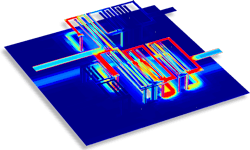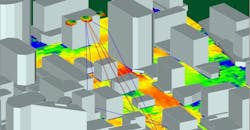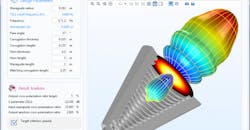Electromagnetic Simulation Software to Watch
For years, software firms have bolstered tools that simulate how electromagnetic fields sprout from antennas, amplifiers, and other parts. Now these programs serve as the starting point for complex designs, providing insight into emissions and coupling issues faster than physical prototypes.
As engineers pack components into smartphones and other small devices like medical implants, interference worsens and hurts receiver sensitivity. To handle a multitude of component shapes and sizes, software tools now come with a number of mathematical programs called solvers, which excel at specific simulation problems.
But few companies are versed in these powerful and arcane equations. Few major software platforms reign as a result. Most can switch between solvers to simulate everything from microwave filters to automotive radar. Some also feature automatic meshing, which involves laying triangular cells on models to prep them for simulation.
Though rare, smaller competitors exist. These tools typically target a single solver optimized for specific species of components, such as horn antennas and passive filters to be installed on planes and cars. Their main selling points are better efficiency and faster calculations. Below is our list of electromagnetic simulation software that engineers should know.
Ansys HFSS One of the industry's most popular tools, HFSS software combines an electromagnetic field simulator with harmonic balance and transient circuit programs. It primarily runs finite element method (FEM) solvers for simulating antennas and automatically adapts meshes. Ansys also sells EMIT, a software tool that identifies interference between multiple radios located in the same car, drone, or smartphone.
CST Microwave Studio Another popular tool for simulating antennas, filters, couplers, and planar and multi-layer structures, Microwave Studio competes with Ansys' HFSS tools. The software suite, which contain both frequency and time domain solvers, are sold by Computer Simulation Technology, which software conglomerate Dassault Systèmes acquired last year for around $242 million.
AWR Microwave Office This software suite, sold by National Instruments’ AWR unit, is widely used for laying out circuits and analyzing everything from amplifiers to mixers to antennas. With tools for both planar and 3D electromagnetic anaylsis, it received an update last month that improves how it handles large numbers of load-pull measurements. New code also simplifies simulations of multi-chip modules, which combine MMIC and RFIC devices on a single laminate package.
Remcom Xfdtd This tool runs special 3D solvers that handle the complex algebra needed to predict how devices will act in the real world. Remcom’s tool can be used to test how antennas, microwave devices, and automotive radar cause electromagnetic interference to each other. The State College, Penn.-based firm also sells radio propagation software, with its latest version using algorithms to predict how millimeter waves will scatter off walls.
Empire XPU Another electromagnetic simulator using finite difference time domain (FDTD) code is IMST’s Empire XPU software. The tool uses a unique adaptive code generation algorithm to analyze planar, multilayer, and conformal circuits as well as multi-pin packages and waveguides, in minutes.
Last year, the 25-year-old IMST released the latest version of the software, which includes a mode for modeling parts in three dimensions and the ability to process simulation batches using Amazon's cloud computing platform. The updates also included a new user interface and wider support for model formats.
Altair FEKO This software falls into the category of tools that analyze electromagnetic fields sprouting from electrically large structures like airplanes and ships. In recent years, the software has been improved with faster solvers, meshing capabilities, and the ability to run hefty simulations using GPUs and high-performance computing clusters. FEKO is part of Altair’s Hyperworks platform.
Starting with MoM solvers over two decades ago, the time and frequency domain software has added a wide range of other algorithms – including FEM and FDTD – that can be swapped out at different steps of the simulation process. For example, users can apply FEKO's MoM solvers when starting to prototype a pacemaker and then shift to an FEM program for the final electromagnetic analysis.
WIPL-D Pro Though not as widely known as Altair’s, this tool also uses MoM algorithms primarily to simulate the electromagnetic effects of metallic and dielectric structures. Serbia’s WIPL intends the software to be used for antenna design and placement on cars, boats, airplanes, and even missiles. The simulator also targets electromagnetic compatibility testing for transmission lines.
The newest WIPL-D update improves the solvers, which now polish off simulations up to five times faster while using less memory. WIPL also released updates to Microwave Pro, which adds microwave circuit solvers to the 3D simulator. With the recent updates, it can analyze linear circuits for noise, gain, and stability.
Mician Other software guns for speed. Mician’s µWave Wizard uses mode-matching algorithms to precisely link virtual building blocks like waveguides and special elements. Avoiding 3D solvers wherever possible, the tool stitches together the responses of each building block in order to simulate the entire microwave system.
This, the company claims, can significantly reduce cycle times and cut development time. Typically, this technology works better with simpler antennas and other devices like filters, couplers, and feeding networks. But Mician, which is based in Bremen, Germany, also sells FEM solvers to wrestle greater complexity.
Sonnet Software Other firms preach accuracy. Sonnet claims that its planar electromagnetic software can model extraction error less than 1% or less for circuits, antennas, and printed circuit boards. Last year, the company, founded in 1983, updated its Sonnet Suite to support Modelithics’ library of passive microwave components and run up to 50% faster using parallel processing.
Sonnet’s software suite include both time and frequency domain circuit simulators. The company, which is based in Syracuse, N.Y., can take into account the effects of dielectric materials and conductor surface finishes, precisely predicting the coupling effects and losses for common transmission lines, including microstrip and stripline.
HFWorks This 3D electromagnetic simulator computes antenna parameters like pattern, gain, directivity, axial ratio, and efficiency, and circuit parameters like scattering and impedance using FEM solvers. Sold by the 17-year-old EMWorks, the software is fully embedded in both Solidworks and Ansys SpaceClaim so that engineers are not forced to build models from scratch.
Comsol Multiphysics The latest version features a library of standard parts models that can be easily shared and modified. Comsol’s RF Module spits out full-wave simulations on thermal effects in microwave filters, signal paths in wireless antennas, and interference in transmission lines. In addition to running electromagnetic compatibility tests, it can simulate 2D and 3D structures grafted onto cars and stealth aircraft.
Keysight EmPro This software from Keysight, the former test equipment unit of Agilent Technologies, is for analyzing electromagnetic effects of packages, bond-wires, antennas, and passives like mixers and multipliers. With solvers for both time and frequency domain simulations, the tool can also be integrated with Keysight’s Advanced Design System (ADS), which competes on the circuit level with National Instruments’ Microwave Office.
About the Author

James Morra
Senior Editor
James Morra is the senior editor for Electronic Design, covering the semiconductor industry and new technology trends, with a focus on power electronics and power management. He also reports on the business behind electrical engineering, including the electronics supply chain. He joined Electronic Design in 2015 and is based in Chicago, Illinois.





